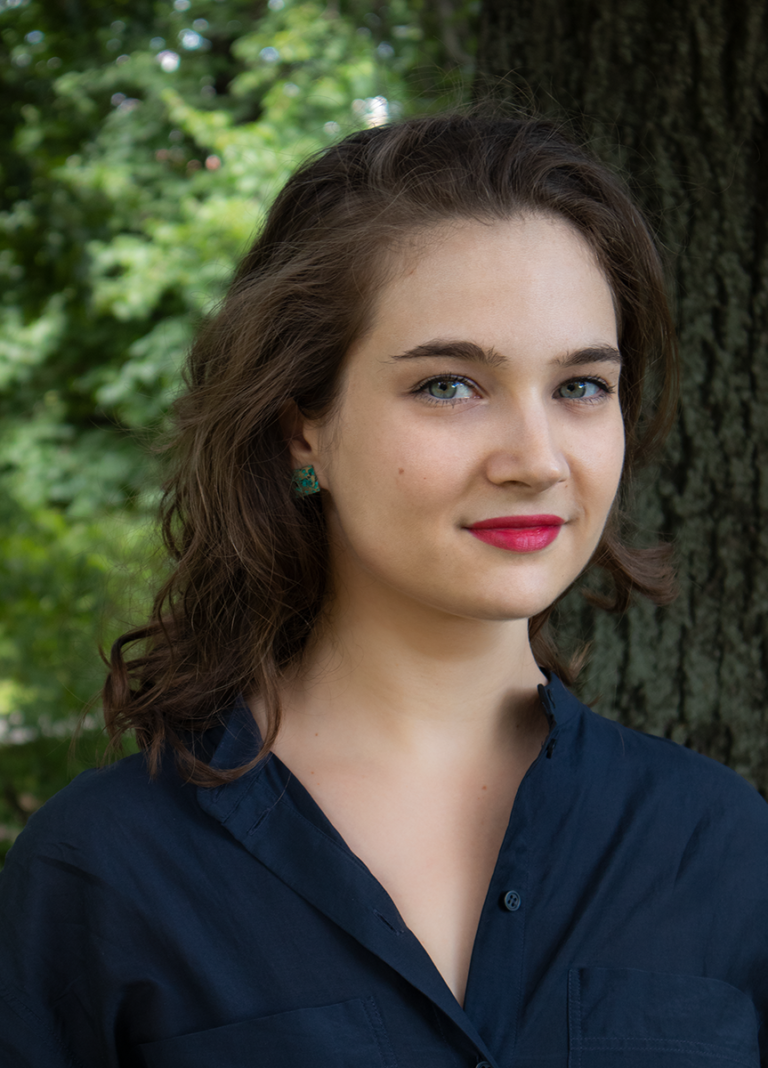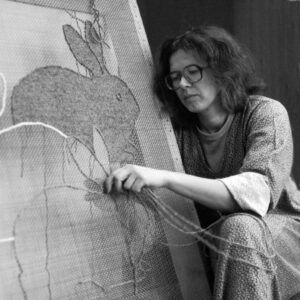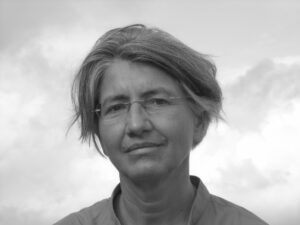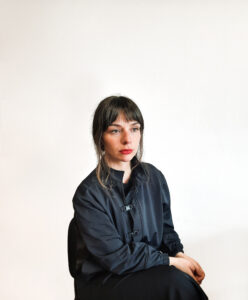Anna Zilahi

– born in 1990, she is a poet and transmedia artist. She graduated from the international economics MA program at the Corvinus University Budapest and further pursued her studies in the field of transmedia art at the University of Applied Arts in Vienna. Her text- and sound-based, often participative works focus on questions of society, ecology and feminism. She is a co-founder of the Budapest-based xtro realm artist group dealing with non-anthropocentric and ecological strands of thought since 2017 (with Rita Süveges and Gideon Horváth). Editor and co-author of the extrodæsia – Encyclopedia towards a Post-Anthropocentric World (2019), a Hungarian-English bilingual dictionary that collects the vocabulary of the Anthropocene in dialogue with poetry and visual artworks. The research-based art project with xtro realm, the ACLIM! Agency for Climate Imaginary! focusing on local ecological challenges was presented in the framework of the OFF-Biennale Budapest’s 3rd edition program. Co-editor of the artist group’s Climate Imaginary Reader published in 2020 as the 9th special issue of the Mezosfera Magazine. Currently, she is experimenting with the possibilities of a more feminine sound art. (Excerpt from the artist’s website). In 2021, she won the Attila Hazai Literary Prize for sovereign, innovative, experimental and risk-taking Hungarian literature.
The sense of sight is the sense of distinction, the sense of separateness, according to Aristotle. By prioritizing sight above all other senses, the extremely visual-centred late capitalist culture emphasizes one’s separateness from the world, from one another, from the objects of the individual’s sight. In the era of the climate crisis, the Western dissociation of ‘us’, humans, from the ‘natural world’ becomes increasingly problematic. I have been exploring how the means of artistic expression are compatible with or can even contribute to the fight against the ecological and climate crisis. I often work with the medium of sound, which connects us with the world. It encompasses us as a constant flux which we also constitute. As an artist, I oppose separateness and atomization through collective and interdisciplinary projects.
My works often have a text-based conceptual starting point, which then evolve into sound pieces and installations12 or into performative and participative projects. In the past five years I became ardent about collaborative synergies and committed to ecological questions. I am an eco-feminist and my approach revolves around connection-making as a field of interest, as well as my method of creation. I believe that nature falls victim to capitalist exploitation much like women are oppressed by patriarchal capitalism: our reproductive powers serve as a background to ever-increasing growth-oriented global production. Connecting and reuniting what has been culturally detached, but essentially belong together is at stake: nature with culture, body with the mind34, logic with the senses, pleasure with pain5, masculine with the feminine6, artistic with the scientific.
This longing for the acknowledgement of the world’s interconnectedness, prompted me to create a choir piece titled Missa Echologica (2021)789, in cooperation with Laura Szári and the Varsányi Szirének feminist choir. This work evokes the plants, animals and minerals of the Northern Lake Balaton region in Hungary, which are now critically threatened by constructions initiated by Hungary’s oligarchy and political elites. Echo, the female protagonist, was previously deprived of her autonomous voice. In this ecofeminist prayer, the non-human agents of the local ecosystem and Echo unite and liberate themselves via the regained female voice and the sense of community and belonging. Questions of who has a voice, who gets to speak and who will be heard makes the medium of sound political. Already in my collection of poems The Whale is not a Motif (2017)10, I pondered the dilemma whether a female author can even express herself. Women have been silenced for so long historically and the literary language one inherits has been developed by generations of male authors. This excludes a wide range of experiences from language. In numerous cases, silencing operates passively; it is a structural givenness: one feels detached from male-dominated discourses, which discourage certain topics. There is some improvement in both the Hungarian literary and art scenes. However, due to the reactionary, repressive and largely misogynistic domestic politics, these feminist achievements are constantly threatened.
I am still pre-occupied with this question to this day. In my most recent performative video piece, Urtica (2022)11, I kept silent while working with the common stinging nettle. Urtica is based on Hans Christian Andersen’s tale ‘The Wild Swans’. In the original tale, the female protagonist saves her brothers, who have been turned into swans, by sewing them an armour shirt from nettle. She could not whimper, cry out or exclaim her pain while sewing. The nettle cloth liberates the brothers and returns their human bodies. Their liberation is only possible through her pain and her acceptance of pain. The performative video piece shows the creation of a nettle dress, prompting a reverse transformation: touching the plant reconnects one with their own non-humanness and animality – their swanness. I became very curious about how pain reconnects one to the body, how it re-channels one’s focus to their own bodily existence. I found the opposite of passivity in this acceptance of touching the stinging nettle: empowerment and agency. In this sense, the silence of creation and thus the qualities regarded as feminine like caring and listening, can be a form of activism as well.
The xtro realm group12 and our practices also indicate how I think about art and its role in society. My collaboration with Rita Süveges and Gideon Horváth strongly shaped my practice since 2017. Xtro realm started as a knowledge-sharing platform discussing new materialist philosophies and ecological thinking to thematise climate issues and to gain a deeper understanding of the crises in relation to how our generation creates art. Our aim was to contribute to a narrative that transcends the anthropocentrism with which Western cultures approach all topics and which is a root cause of the climate problem. We organized reading sessions, excursions13, publications1415, lectures and exhibitions1617, which drove knowledge creation and forged a new community of people who were united as collaborators by their shared interests. Our network-building, transdisciplinary and research-based modus operandi reflects my vision of art well.
The statement was written in collaboration with art historian Viktória Popovics (2022).
1Image: Anna Zilahi, Shadow of Breath, 2017, sound installation, loop. Photo by Marie Reichel, courtesy of the artist.2Image: Anna Zilahi, Clouds Unplugged, 2018, sound installation, loop. Courtesy of the artist.
3Image: Anna Zilahi, The River Knows Better, 2019, poem meditation, 13”, installation view, Studio Gallery. Photo by Dániel Kophelyi, courtesy of the artist.
4Listen to the poem meditation here: soundcloud.com/user-204562680/the-river-knows-better-ophelia-lives.
5Image: Anna Zilahi, Urtica, 2022, performative video work, 6’20”. Photo by Gergely Ofner, courtesy of the artist.
6Image: Anna Zilahi, La mort du Papillon, performance, 2017. Photo by Victor Jaschke, courtesy of the artist. See: annazilahi.com/art/la-mort-du-papillon.
7See: https://vimeo.com/638000498.
8See: artmargins.com/one-on-one-interview-with-anna-zilahi-missa-echologica-2021/.
9Image: Anna Zilahi, Missa Echologica, 13”, 2021. Still, photo by Gergely Ofner, courtesy of the artist.
10See: amberflora.com/issues/issue-9/anna-zilahi-owen-good-two-poems/.
11Image: Still from Urtica, 2022, performative video work, 6’20”. Photo by Gergely Ofner, courtesy of the artist.
12See: xtrorealm.hu.
13Image: Százhalombatta oil refinery field trip, 2019. Photo of the artist.
14Image: Anna Zilahi, Extrodaesia, 2019. Photo by Gideon Horváth, courtesy of the artist.
15Climate Imaginary Reader: mezosfera.org/category/9-climate-imaginary-reader/.
16See: xtrorealm.hu/project/xtro-realm-show/.
17See: aclim.hu.
– szül. 1990, költő, prózaíró, képzőművész. Tanulmányait a Budapesti Corvinus Egyetem nemzetközi gazdálkodás szakán és a bécsi Universität für angewandte Kunst transzmédia művészet szakán végezte.Szövegközpontú, hangművészeti és részvétel alapú munkái társadalmi és ökológiai jelenségekkel foglalkoznak, azokat feminista perspektívából vizsgálja. Alapító tagja az ökológiai kihívásokkal és az antropocentrikus gondolkodás kritikájával foglalkozó xtro realm művészcsoportnak (Süveges Ritával és Horváth Gideonal). Szerkesztője és szerzője a kollektíva által 2019-ben kiadott extrodæsia – Enciklopédia egy emberközpontúságot meghaladó világhoz című kétnyelvű szócikk-, kép- és versgyűjteménynek. A csoport szervezésében valósult meg az ACLIM! Klímaképzeleti Ügynökség című kiállítás a 2021-es OFF-Biennále Budapest programjában, mely az ökológiai válság lokális témáit dolgozta fel természettudósok és társadalomtudósok bevonásával. 2020-ban társszerkesztője a Klímaképzelet Reader című cikksorozatnak, mely magyarul a tranzitblog.hu-n, angolul pedig a Mezosfera.org online magazinban jelent meg. Egyéni művészeti munkájának fókuszában jelenleg a feminista hangművészet lehetőségeinek keresése áll. (részlet a művész honlapjáról). 2021-ben elnyerte az Attila Hazai Irodalmi Díjat szuverén, innovatív, kísérleti és kockázatvállaló magyar irodalomért.
A látás Arisztotelész szerint a megkülönböztetés, az elválasztás érzéke. A késő kapitalizmus szélsőségesen vizualitás-központú kultúrájában a látás minden más érzék fölé helyezése az egyén leválasztottságát erősíti meg, azaz elkülönülését a világtól, a többi embertől és tekintetének tárgyától. A klímaválság korában a “mi”, az ember, és a természeti világ nyugati gondolkodásmód szerinti elválasztása egyre problematikusabb. Munkámban azt vizsgálom, hogy a művészi kifejezés különböző módjai hogyan járulhatnak hozzá az ökológiai és a klímaválság elleni küzdelemhez. Gyakran dolgozom a hanggal mint médiummal, amely összeköt a világgal. A hang folyamatos áramlásként vesz körül bennünket, melynek létrejöttéhez mi magunk is hozzájárulunk. Alkotóként számomra az elkülönülésre és atomizációra a kollektív és interdiszciplináris projektek jelentenek választ.
A munkáim gyakran szövegalapú, konceptuális kezdőpontból indulnak, amelyek aztán hangművészeti alkotássá, installációvá12 vagy performatív és részvételi projektté alakulnak. Az elmúlt öt évben a művészeti együttműködések és az ökológiai témák mellett köteleztem el magam. Ökofeministaként meggyőződésem, hogy a természet éppúgy a kapitalista kizsákmányolás áldozatává válik, mint ahogy a nők a patriarchális kapitalista rendszer elnyomottjai: reproduktív erőink a folyamatos növekedést célzó globális termelés hátterét képezik. Alkotói módszerem és fókuszom egyaránt a különböző dolgok közötti kapcsolatteremtés. A tét számomra a kulturális értelemben szétválasztott, de alapvetően összetartozó dolgok újraegyesítése: a természet és a kultúra, a test és az elme34, a logika és az érzékek, az öröm és a fájdalom5, a maszkulin és a feminin6, vagy éppen a művészet és a tudomány összekapcsolása.
A Missa Echologica (2021)789 című, Szári Laurával és a Varsányi Szirének feminista kórussal együttműködésben készült kórusmű is ebben a szellemiségben született. A mű a Balaton északi partjának növény- és állatvilágát, ásványkincseit énekli meg, melyek a magyar politikai és gazdasági elit által kezdeményezett környezetpusztító építkezéseknek áldozatul estek. A kórusmű női főszereplőjét, Echót büntetésből megfosztották saját hangjától. A kilenc versszakos ökofeminista imádságban a helyi ökoszisztéma nem emberi szereplői és Echo közösségre lépnek és felszabadítják a női hangot, és ezáltal önmagukat is. Kinek van hangja, ki az, aki megszólalhat, és kit hallgatnak meg? – többek között ezek a kérdésfeltevések teszik a hang médiumát politikaivá. Már A bálna nem motívum (2017)10 című verseskötetemben is az a dilemma foglalkoztatott, hogy női szerzőként képes vagyok-e egyáltalán a megszólalásra, az önkifejezésre? A nőket évezredeken át elhallgattatták, magát az irodalmi nyelvet is férfi szerzők generációi örökítették ránk. Ez az emberi tapasztalás széles körét zárja ki a nyelvből. Az elhallgattatás sok esetben passzív módon történik, strukturális adottságként, melyben a férfiak által dominált diskurzusokról leválasztva érezzük magunkat, és ahol bizonyos témák meg sem jelennek. Ugyan a magyar irodalmi és művészeti színtéren van némi előrelépés e tekintetben, azonban a reakciós, elnyomó és nőgyűlölő helyi politika folyamatos veszélyt jelent e feminista eredményekre nézve.
A munkáimban ezek a kérdések rendre visszatérnek. A legutóbbi performatív videómban (Urtica, 2022)11 csalánnal dolgoztam. Az Urtica Hans Christian Andersen A vadhattyúk című meséjén alapszik, melyben a női főszereplő hattyúvá változtatott fivéreit egy csalánból szőtt páncéling segítségével menti meg. A csalánszövet felszabadítja a testvéreket, akik általa visszakapják emberi testüket. Megváltásuk ugyanakkor csak a nővér fájdalmával, a fájdalom elfogadásával lehetséges. A performatív videó a csalánruha létrehozását mutatja be, amely a meséhez képest fordított átalakulást idéz elő: a növény megérintése összekapcsolja az embert a saját, nem emberi mivoltával és animalitásával – hattyúságával. Kíváncsi lettem arra, hogy a fájdalom hogyan köt minket össze a testünkkel, és hogyan tereli vissza a figyelmünket a testi létünkre. A csalán érintésének elfogadásában a tétlenség ellentétére találtam: cselekvőképességet éltem meg. Ennek megfelelően az alkotás csendje és a femininnek tartott tulajdonságok, azaz a gondoskodás és a (meg)hallgatás az aktivizmus lehetséges formáiként értelmezhetők.
Ahogyan a művészetről és annak társadalomban betöltött szerepéről gondolkodom, azt az xtro realm csoporttal12 közösen folytatott művészeti gyakorlatunkban is megnyilvánul.Együttműködésem Süveges Ritával és Horváth Gideonnal 2017 óta nagy mértékben formálta a saját alkotói megközelítésemet. Az xtro realm művészcsoport tulajdonképpen egy tudásmegosztáson alapuló platform, ahol az új materialista filozófia és az ökológiai gondolkodás segítségével vitatjuk meg a klímaválság kérdéseit. Szerettük volna mélyebben megérteni a sorozatos civilizációs kríziseket és ezek tükrében azt, hogy a generációnk hogyan hoz létre művészetet. Célunk egy olyan narratíva felépítése volt, amely túllép a nyugati világ antropocentrikus világképén, mely a klímaválsághoz is nagyban hozzájárul. Olvasóköröket, kirándulásokat szerveztünk13, kiadványokat,1415 kiállításokat hozunk létre1617, előadásokat tartottunk, amelyekből új tudás, valamint egy olyan közösség is született, ahol a résztvevőket a közös érdeklődésük együttműködő partnerekké tette. Ez a fajta közösségépítésen, transzdiszciplináris módszereken és kutatáson alapuló működésmód jól tükrözi a művészettel kapcsolatos víziómat.
A statement a művész és Popovics Viktória művészettörténész közreműködésében jött létre (2022).
1Kép: Zilahi Anna, Shadow of Breath, 2017, hang installáció, loop. Fotó: Marie Reichel, a művész jóvoltából.2Kép: Zilahi Anna, Clouds Unplugged, 2018, hang installáció, loop. A művész jóvoltából.
3Kép: Zilahi Anna, The River Knows Better, 2019, meditációs hangköltemény és részvételi performansz, 13”, enteriőr kép, Studio Gallery. Fotó: Kophelyi Dániel, a művész jóvoltából.
4A meditációs hangköltemény itt hallgatható meg: soundcloud.com/user-204562680/the-river-knows-better-ophelia-lives.
5Kép: Zilahi Anna, Urtica, 2022, performatív videó, 6’20”. Fotó: Ofner Gergely, a művész jóvoltából.
6Kép: Zilahi Anna, La mort du Papillon (A pillangó halála), performansz, 2017. Fotó: Victor Jaschke, a művész jóvoltából. Lásd: annazilahi.com/art/la-mort-du-papillon.
7Lásd: vimeo.com/638000498.
8Lásd: artmargins.com/one-on-one-interview-with-anna-zilahi-missa-echologica-2021/.
9Kép: Zilahi Anna, Missa Echologica, 2021, videó 13”, kórusmű, performansz. Fotó: Gergely Ofner, a művész jóvoltából.
10Lásd: amberflora.com/issues/issue-9/anna-zilahi-owen-good-two-poems/.
11Kép: Urtica, 2022, performatív videó, 6’20”. Fotó Ofner Gergely, a művész jóvoltából.
12Lásd: xtrorealm.hu.
13Kép: Százhalombatta olajfinomító, 2019. A művész felvétele.
14Kép: Zilahi Anna, Extrodaesia, 2019. Fotó: Horváth Gideon, a művész jóvoltából.
15Climate Imaginary Reader: mezosfera.org/category/9-climate-imaginary-reader/.
16Lásd: xtrorealm.hu/project/xtro-realm-show/.
17Lásd: aclim.hu.


